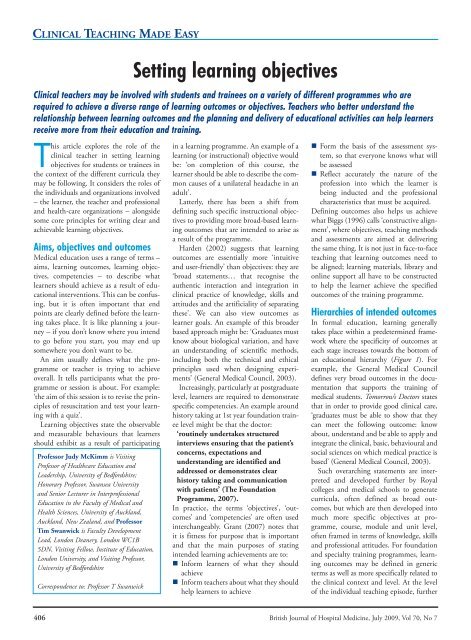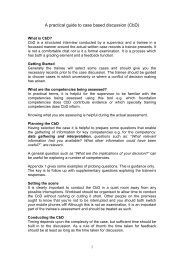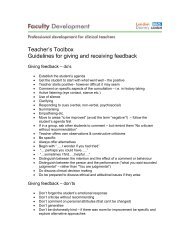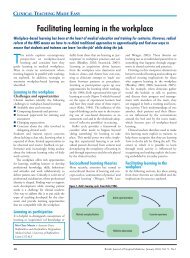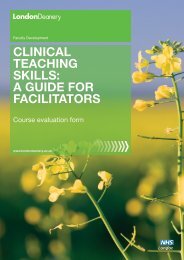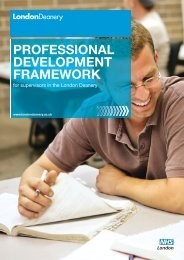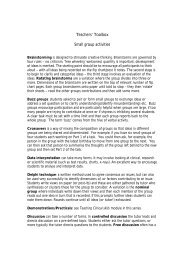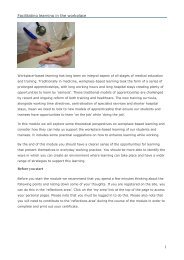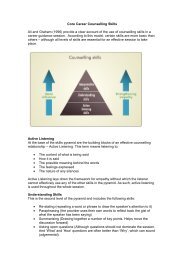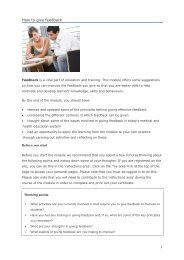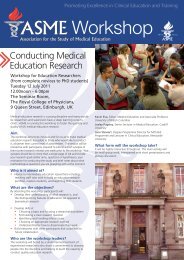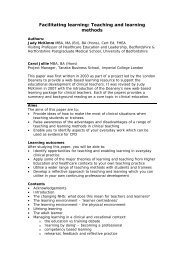Setting learning objectives - Faculty Development - London Deanery
Setting learning objectives - Faculty Development - London Deanery
Setting learning objectives - Faculty Development - London Deanery
You also want an ePaper? Increase the reach of your titles
YUMPU automatically turns print PDFs into web optimized ePapers that Google loves.
Clinical Teaching Made Easy<br />
This article explores the role of the<br />
clinical teacher in setting <strong>learning</strong><br />
<strong>objectives</strong> for students or trainees in<br />
the context of the different curricula they<br />
may be following. It considers the roles of<br />
the individuals and organizations involved<br />
– the learner, the teacher and professional<br />
and health-care organizations – alongside<br />
some core principles for writing clear and<br />
achievable <strong>learning</strong> <strong>objectives</strong>.<br />
Aims, <strong>objectives</strong> and outcomes<br />
Medical education uses a range of terms –<br />
aims, <strong>learning</strong> outcomes, <strong>learning</strong> <strong>objectives</strong>,<br />
competencies – to describe what<br />
learners should achieve as a result of educational<br />
interventions. This can be confusing,<br />
but it is often important that end<br />
points are clearly defined before the <strong>learning</strong><br />
takes place. It is like planning a journey<br />
– if you don’t know where you intend<br />
to go before you start, you may end up<br />
somewhere you don’t want to be.<br />
An aim usually defines what the programme<br />
or teacher is trying to achieve<br />
overall. It tells participants what the programme<br />
or session is about. For example:<br />
‘the aim of this session is to revise the principles<br />
of resuscitation and test your <strong>learning</strong><br />
with a quiz’.<br />
Learning <strong>objectives</strong> state the observable<br />
and measurable behaviours that learners<br />
should exhibit as a result of participating<br />
<strong>Setting</strong> <strong>learning</strong> <strong>objectives</strong><br />
Clinical teachers may be involved with students and trainees on a variety of different programmes who are<br />
required to achieve a diverse range of <strong>learning</strong> outcomes or <strong>objectives</strong>. Teachers who better understand the<br />
relationship between <strong>learning</strong> outcomes and the planning and delivery of educational activities can help learners<br />
receive more from their education and training.<br />
Professor Judy McKimm is Visiting<br />
Professor of Healthcare Education and<br />
Leadership, University of Bedfordshire;<br />
Honorary Professor, Swansea University<br />
and Senior Lecturer in Interprofessional<br />
Education in the <strong>Faculty</strong> of Medical and<br />
Health Sciences, University of Auckland,<br />
Auckland, New Zealand, and Professor<br />
Tim Swanwick is <strong>Faculty</strong> <strong>Development</strong><br />
Lead, <strong>London</strong> <strong>Deanery</strong>, <strong>London</strong> WC1B<br />
5DN, Visiting Fellow, Institute of Education,<br />
<strong>London</strong> University, and Visiting Professor,<br />
University of Bedfordshire<br />
Correspondence to: Professor T Swanwick<br />
in a <strong>learning</strong> programme. An example of a<br />
<strong>learning</strong> (or instructional) objective would<br />
be: ‘on completion of this course, the<br />
learner should be able to describe the common<br />
causes of a unilateral headache in an<br />
adult’.<br />
Latterly, there has been a shift from<br />
defining such specific instructional <strong>objectives</strong><br />
to providing more broad-based <strong>learning</strong><br />
outcomes that are intended to arise as<br />
a result of the programme.<br />
Harden (2002) suggests that <strong>learning</strong><br />
outcomes are essentially more ‘intuitive<br />
and user-friendly’ than <strong>objectives</strong>: they are<br />
‘broad statements… that recognise the<br />
authentic interaction and integration in<br />
clinical practice of knowledge, skills and<br />
attitudes and the artificiality of separating<br />
these’. We can also view outcomes as<br />
learner goals. An example of this broader<br />
based approach might be: ‘Graduates must<br />
know about biological variation, and have<br />
an understanding of scientific methods,<br />
including both the technical and ethical<br />
principles used when designing experiments’<br />
(General Medical Council, 2003).<br />
Increasingly, particularly at postgraduate<br />
level, learners are required to demonstrate<br />
specific competencies. An example around<br />
history taking at 1st year foundation trainee<br />
level might be that the doctor:<br />
‘routinely undertakes structured<br />
interviews ensuring that the patient’s<br />
concerns, expectations and<br />
understanding are identified and<br />
addressed or demonstrates clear<br />
history taking and communication<br />
with patients’ (The Foundation<br />
Programme, 2007).<br />
In practice, the terms ‘<strong>objectives</strong>’, ‘outcomes’<br />
and ‘competencies’ are often used<br />
interchangeably. Grant (2007) notes that<br />
it is fitness for purpose that is important<br />
and that the main purposes of stating<br />
intended <strong>learning</strong> achievements are to:<br />
• Inform learners of what they should<br />
achieve<br />
• Inform teachers about what they should<br />
help learners to achieve<br />
• Form the basis of the assessment system,<br />
so that everyone knows what will<br />
be assessed<br />
• Reflect accurately the nature of the<br />
profession into which the learner is<br />
being inducted and the professional<br />
characteristics that must be acquired.<br />
Defining outcomes also helps us achieve<br />
what Biggs (1996) calls ‘constructive alignment’,<br />
where <strong>objectives</strong>, teaching methods<br />
and assessments are aimed at delivering<br />
the same thing. It is not just in face-to-face<br />
teaching that <strong>learning</strong> outcomes need to<br />
be aligned; <strong>learning</strong> materials, library and<br />
online support all have to be constructed<br />
to help the learner achieve the specified<br />
outcomes of the training programme.<br />
Hierarchies of intended outcomes<br />
In formal education, <strong>learning</strong> generally<br />
takes place within a predetermined framework<br />
where the specificity of outcomes at<br />
each stage increases towards the bottom of<br />
an educational hierarchy (Figure 1). For<br />
example, the General Medical Council<br />
defines very broad outcomes in the documentation<br />
that supports the training of<br />
medical students. Tomorrow’s Doctors states<br />
that in order to provide good clinical care,<br />
‘graduates must be able to show that they<br />
can meet the following outcome: know<br />
about, understand and be able to apply and<br />
integrate the clinical, basic, behavioural and<br />
social sciences on which medical practice is<br />
based’ (General Medical Council, 2003).<br />
Such overarching statements are interpreted<br />
and developed further by Royal<br />
colleges and medical schools to generate<br />
curricula, often defined as broad outcomes,<br />
but which are then developed into<br />
much more specific <strong>objectives</strong> at programme,<br />
course, module and unit level,<br />
often framed in terms of knowledge, skills<br />
and professional attitudes. For foundation<br />
and specialty training programmes, <strong>learning</strong><br />
outcomes may be defined in generic<br />
terms as well as more specifically related to<br />
the clinical context and level. At the level<br />
of the individual teaching episode, further<br />
406 British Journal of Hospital Medicine, July 2009, Vol 70, No 7<br />
BJHM_406_409_CTME_objective.indd406 406 29/6/09 10:51:15
Clinical Teaching Made Easy<br />
specificity arises as the intended outcomes<br />
of a particular educational intervention,<br />
teaching or supervision session, are tailored<br />
to the needs of individual learners.<br />
Prescription or process?<br />
Learning outcomes or <strong>objectives</strong> can be<br />
seen as the building blocks of any <strong>learning</strong><br />
programme or teaching or <strong>learning</strong> event<br />
and as key to ensuring that all aspects of a<br />
programme – <strong>learning</strong> methods, assessment,<br />
evaluation and quality assurance –<br />
link together. The teacher’s role is to ensure<br />
that each session integrates with the whole<br />
curriculum by providing opportunities for<br />
learners to achieve the stated <strong>objectives</strong> and<br />
thus be capable of passing assessments.<br />
When planning a session or programme,<br />
paying attention to how the outcomes will<br />
be achieved, assessed and evaluated requires<br />
active and overt consideration of the educational<br />
process: the interaction of teachers,<br />
students and knowledge. Stenhouse<br />
(1975) thought of an objective-led curriculum<br />
as an educational ‘straitjacket’, proposing<br />
a shift to a process-driven model in<br />
which the facilitation of <strong>learning</strong> is the<br />
central concern, and outcomes become<br />
unpredictable. Hussey and Smith (2008)<br />
call this the ‘corridor of tolerance’, allowing<br />
space for <strong>learning</strong> outcomes to emerge<br />
through the <strong>learning</strong> process. A thoughtful<br />
curriculum includes outcomes with varying<br />
levels of detail, enabling achievement<br />
of tasks, while acknowledging the importance<br />
of the process of <strong>learning</strong>. Medical<br />
curricula are now re-emphasizing the<br />
importance of students and trainees having<br />
opportunities to become immersed in<br />
clinical contexts, <strong>learning</strong> through experience.<br />
An example of a process objective<br />
Figure 1. Levels at which <strong>learning</strong> outcomes may be defined.<br />
might be: ‘to spend time with the district<br />
nurse and explore how the service works.’<br />
Learning <strong>objectives</strong> and<br />
professional development<br />
Two models help us understand how<br />
<strong>learning</strong> outcomes or <strong>objectives</strong> relate to<br />
learners’ professional development as they<br />
move from novice to expert.<br />
Bloom<br />
The first is found in Bloom’s taxonomy of<br />
<strong>objectives</strong> in the cognitive domain (1956),<br />
which describes how <strong>objectives</strong> related to<br />
cognitive development increase in complexity<br />
as learners develop deeper understanding,<br />
start to apply this knowledge and ultimately<br />
synthesize and evaluate what they<br />
have learned. From your own experience<br />
you will know that as your clinical understanding<br />
developed, you became better able<br />
to handle complex information from multiple<br />
sources and synthesize it quickly and<br />
precisely to make consistently accurate<br />
diagnoses and decisions. Although this runs<br />
counter to experiential <strong>learning</strong> approaches<br />
in which <strong>learning</strong> happens by ‘doing’ (Kolb,<br />
1984), Bloom’s taxonomy has been highly<br />
influential in all areas of education.<br />
Figure 2 shows how these levels increase<br />
in complexity as learners advance. Bloom’s<br />
model can be used to help write <strong>objectives</strong><br />
or outcomes where they can be mapped on<br />
to the appropriate level, depending on<br />
what learners are expected to achieve. A<br />
common mistake in writing outcomes is to<br />
set them at the wrong level; either expecting<br />
learners to be able to do something for<br />
which they are not yet ready, or inappropriately<br />
linking them to particular teaching<br />
and <strong>learning</strong> methods or assessments.<br />
Miller<br />
Another model that is particularly useful<br />
for thinking about <strong>learning</strong> outcomes in<br />
relation to assessment of clinical competence<br />
is Miller’s pyramid (1990) (Figure 3).<br />
This model is similar to Bloom’s taxonomy<br />
in that there is a marked shift, as professionals<br />
develop expertise, from being able to<br />
demonstrate the knowledge underpinning<br />
competence (e.g. knowing theoretically<br />
how to examine an abdomen) to ‘doing in<br />
action’, where knowledge, skills and professional<br />
attitudes are synthesized and internalized<br />
into a seamless routine that can be<br />
carried out in different contexts.<br />
Both these models can help us to match<br />
<strong>learning</strong> outcomes with our expectations<br />
of what the learner should be able to do at<br />
any stage. Students and trainees relate to<br />
knowledge and understanding at a more<br />
basic level – possibly in artificial or limited<br />
contexts – than to the actual high-level<br />
performance expected of consultants.<br />
Figure 2. Thinking like a professional? Bloom’s<br />
taxonomy and professional development.<br />
Knowledge<br />
Evaluation<br />
Synthesis<br />
Analysis<br />
Application<br />
Comprehension<br />
Expert<br />
Trainee<br />
Undergraduate<br />
Figure 3. Miller’s pyramid for assessing clinical<br />
competence. Adapted from Norcini (2007).<br />
Statutory and regulatory frameworks: General Medical Council,<br />
Quality Assurance Agency<br />
Royal Colleges: specialist training curricula, foundation curricula<br />
Medical schools: undergraduate medicine programmes<br />
Course modules or course units<br />
Single teaching or <strong>learning</strong> sessions<br />
Virtual <strong>learning</strong> environment<br />
Learning resource centre<br />
Self-directed or directed <strong>learning</strong> by individual learner<br />
Professional expertise<br />
Does Action<br />
Shows how Performance<br />
Knows how Competence<br />
Knows<br />
Knowledge<br />
British Journal of Hospital Medicine, July 2009, Vol 70, No 7 407<br />
BJHM_406_409_CTME_objective.indd407 407 29/6/09 10:51:15
Clinical Teaching Made Easy<br />
Writing <strong>learning</strong> outcomes or<br />
<strong>objectives</strong><br />
Learning <strong>objectives</strong> will relate to one of the<br />
three domains described by Bloom (1956):<br />
1. Cognitive (knowledge and intellectual<br />
skills)<br />
2. Psychomotor (physical skills)<br />
3. Affective (feelings and attitudes).<br />
They specify the intended end point of<br />
engagement in a given <strong>learning</strong> activity and:<br />
• Are written in the future tense<br />
• Use easily understood language<br />
• Relate to explicit statements of achievement<br />
and always contain verbs<br />
• Clearly indicate the nature and/or level<br />
of <strong>learning</strong> required for achievement<br />
• Avoid ambiguity or over-complexity<br />
• Are SMART: specific, measurable,<br />
achievable, realistic and timebound.<br />
When writing <strong>objectives</strong>, always start with<br />
a stem, such as: ‘At the end of this session,<br />
learners will be able to…’ then use a verb,<br />
that states specifically what the learners will<br />
be able to do, e.g. ‘…demonstrate…’ followed<br />
by a clear statement of the topic of<br />
interest ‘…that they can administer an<br />
intramuscular injection’.<br />
Knowledge <strong>objectives</strong><br />
When writing <strong>objectives</strong> that relate to<br />
knowledge, there are a number of useful<br />
verbs that can be used to map the <strong>learning</strong><br />
outcome onto the relevant tier of Bloom’s<br />
taxonomy (Table 1). An example might be:<br />
‘At the end of this session, learners will be<br />
able to describe the key features of hypertension<br />
in adults’. For this <strong>learning</strong> objective,<br />
typical teaching and <strong>learning</strong> methods<br />
might be a lecture, seminar, tutorial, problem-based<br />
<strong>learning</strong> case or clinical scenario.<br />
We are not asking the learners to apply<br />
knowledge, therefore assessment would<br />
aim to assess understanding and recall of<br />
the key features of hypertension in adults.<br />
Table 1. Writing <strong>objectives</strong> in the cognitive domain<br />
Skills <strong>objectives</strong><br />
Bloom suggested that skills <strong>objectives</strong><br />
should be written in terms of competence.<br />
He called this the psychomotor domain<br />
(although this taxonomy was completed by<br />
others) and ascribed to it five levels:<br />
1. Imitation (observes skill and tries to<br />
reproduce it)<br />
2. Manipulation (performs skill from<br />
instruction)<br />
3. Precision (reproduces skill with accuracy<br />
and proportion)<br />
4. Articulation (combines one or more<br />
skills in sequence with harmony and<br />
consistency)<br />
5. Naturalization (completes skilful tasks<br />
competently and automatically).<br />
Note the similarity to Miller’s pyramid.<br />
An example of a skills-based objective at<br />
the level of ‘precision’ would be: ‘At the end<br />
of the training session, learners will be able<br />
to insert a cannula into a peripheral vein<br />
accurately without causing a haematoma’.<br />
Teaching and <strong>learning</strong> methods for this<br />
domain may well include some background<br />
knowledge, such as relevant anatomy and<br />
physiology or equipment needs, but for<br />
learners to be able to perform this skill accurately,<br />
they need to practise. This may be on<br />
models, or with supervision and feedback.<br />
Assessment of competence would involve a<br />
number of observations, not just asking the<br />
learner to describe what he/she would do.<br />
Attitudinal <strong>objectives</strong><br />
Attitudinal <strong>objectives</strong> are often seen as the<br />
most difficult to write because they describe<br />
patterns of observable behaviour. Bloom<br />
called this the affective domain and again it<br />
has five levels:<br />
1. Receiving (aware of external stimuli,<br />
e.g. listening)<br />
2. Responding (complies with expectations<br />
in response to stimuli)<br />
Description<br />
Useful verbs for outcome level statements<br />
Knowledge Recall of information previously presented Define, list, name, recall, record<br />
Comprehension Grasping the meaning but not extending it Describe, explain, discuss, recognize<br />
beyond the present situation<br />
Application Using the rules and principles Apply, use, demonstrate, illustrate, practice<br />
Analysis Breaking down components to clarify Distinguish, analyse, calculate, test, inspect<br />
Synthesis Arranging and assembling elements into a whole Design, organize, formulate, propose<br />
Evaluation Ability to judge X for a purpose Judge, appraise, evaluate, compare, assess<br />
3. Valuing (displays behaviour consistent<br />
with a single belief without coercion)<br />
4. Organizing (shows commitment to a set<br />
of values by behaviour)<br />
5. Characterizing (behaviour consistent<br />
with a value system).<br />
An example in this domain (at the level of<br />
responding) might be: ‘At the end of the<br />
communications skills course, learners<br />
will be able to demonstrate awareness of<br />
cultural differences in working with simulated<br />
patients in three different clinical<br />
scenarios.’<br />
This <strong>learning</strong> objective focuses on the<br />
learners being able to show that they<br />
understand and can respond to different<br />
(pre-defined in this case) cultural issues<br />
that patients may present. This objective<br />
states clearly that learners are not expected<br />
to demonstrate this awareness outside a<br />
simulated context, so not in the ‘real world’<br />
of the ward.<br />
Lesson planning<br />
It is at the level of the individual teaching<br />
session that clinical teachers need to integrate<br />
the <strong>learning</strong> needs of their students or<br />
trainees with defined <strong>learning</strong> <strong>objectives</strong>.<br />
This can be achieved by asking four fundamental<br />
questions when planning teaching<br />
(adapted from Spencer, 2003):<br />
1. Who am I teaching? (The number of<br />
learners and their level)<br />
2. What am I teaching? (The topic or subject,<br />
the type of expected <strong>learning</strong>, e.g.<br />
knowledge, skills or attitudes)<br />
3. How will I teach it? (Teaching and<br />
<strong>learning</strong> methods, length of time available,<br />
location of teaching session, access<br />
to patients and resources)<br />
4. How will I know if the students understand?<br />
(Informal and formal assessments,<br />
questioning techniques, feedback<br />
from learners).<br />
You might also want to ask:<br />
• What do they know already?<br />
• Where have they come from and what<br />
are they going on to next?<br />
• What do the learners want as a result of<br />
the teaching and how can I find this<br />
out?<br />
• How can I build in sufficient flexibility<br />
to cope with emerging needs?<br />
For each teaching session it helps to formulate<br />
a ‘lesson plan’. This may be very<br />
detailed or a simple broad brush outline,<br />
but before each session you should:<br />
408 British Journal of Hospital Medicine, July 2009, Vol 70, No 7<br />
BJHM_406_409_CTME_objective.indd408 408 29/6/09 10:51:16
Clinical Teaching Made Easy<br />
• Define your aims and <strong>learning</strong> outcomes<br />
or <strong>objectives</strong><br />
• Think about the structure of the session<br />
and timing of activities<br />
• Decide on the best teaching and <strong>learning</strong><br />
methods to achieve <strong>learning</strong> outcomes<br />
• List content and key topics, research<br />
more if needed<br />
• Refine your lesson plan<br />
• Identify <strong>learning</strong> resources and support<br />
materials<br />
• Finalize any linked assessment or evaluation.<br />
Common pitfalls and how to<br />
avoid them<br />
Careful planning helps teachers avoid some<br />
common pitfalls when setting <strong>learning</strong><br />
outcomes for teaching and <strong>learning</strong> activities.<br />
Table 2 lists some ways teachers might<br />
avoid these.<br />
Conclusions<br />
<strong>Setting</strong> <strong>learning</strong> <strong>objectives</strong> is a central<br />
activity for clinical teachers and the concept<br />
of pre-determined intended outcomes<br />
underpins all teaching, <strong>learning</strong> and assessment<br />
activities. Opportunities for setting<br />
<strong>learning</strong> <strong>objectives</strong> arise in formal planned<br />
educational activities as well as in more<br />
informal ‘moment to moment’ situations.<br />
Clinical teachers can optimize teaching<br />
and <strong>learning</strong> opportunities that arise in<br />
daily practice and support learners’ professional<br />
development, through an in-depth<br />
understanding of the programme of study<br />
in which the learner is engaged, effective<br />
lesson planning and a continuous consideration<br />
of learners’ needs. BJHM<br />
Conflict of interest: Professor Swanwick is the <strong>Faculty</strong><br />
<strong>Development</strong> Lead for the <strong>London</strong> <strong>Deanery</strong> and Professor<br />
McKimm was commissioned by the <strong>London</strong> <strong>Deanery</strong> to<br />
lead on the development of the suite of e-<strong>learning</strong> modules<br />
from which these articles have been derived.<br />
Biggs J (1996) Enhancing <strong>learning</strong> through<br />
constructive alignment. Higher Education 32:<br />
347–64<br />
Bloom BS, ed. (1956) Taxonomy of Educational<br />
Objectives. David McKay Company Inc,New York<br />
General Medical Council (2003) Tomorrow’s Doctors.<br />
General Medical Council, <strong>London</strong><br />
Grant J (2007) Principles of Curriculum Design.<br />
Association for the Study of Medical Education,<br />
Edinburgh<br />
Harden RM (2002) Learning outcomes and<br />
instructional <strong>objectives</strong>: is there a difference? Med<br />
Teach 24: 151–5<br />
Hussey T, Smith P (2008) Learning outcomes: a<br />
conceptual analysis. Teaching in Higher Education<br />
13(1): 107–15<br />
Kolb DA (1984) Experiential Learning: experience as<br />
the source of <strong>learning</strong> and development. Prentice<br />
Hall, Englewood-Cliffs, NJ<br />
Miller G, ed. (1990) Teaching and Learning in<br />
Medical School. Harvard University Press,<br />
Cambridge, MA<br />
Norcini J (2007) Workplace-based Assessment in<br />
Clinical Training. Association for the Study of<br />
Medical Education, Edinburgh<br />
Table 2. Common pitfalls and how to avoid them<br />
Some pitfalls<br />
…and how to avoid them<br />
Spencer J (2003) ABC of <strong>learning</strong> and teaching in<br />
medicine: <strong>learning</strong> and teaching in the clinical<br />
environment. BMJ 326: 591–4<br />
Stenhouse L (1975) An Introduction to Curriculum<br />
Research and <strong>Development</strong>. Heinemann, <strong>London</strong><br />
The Foundation Programme (2007) Curriculum.<br />
www.foundationprogramme.nhs.uk/pages/home/<br />
key-documents (accessed 16 June 2009)<br />
Trying to achieve too Plan the session carefully, and allow time for discussion, activities and reflection<br />
much in one session<br />
Trying to cover too many Stick to a small number of <strong>learning</strong> outcomes (fewer than five) and be as<br />
<strong>learning</strong> outcomes specific as you can in terms of exactly what you are expecting the learners to be<br />
able to do at the end of the session<br />
Learning outcomes not Make sure you know and understand the programme outcomes, the<br />
linked to the programme assessments the learners are working towards and the expectations of you<br />
or to learner needs and by course organizers, particularly the outcomes and assessments that relate<br />
prior experience specifically to your session(s). Include informal and formal activities that help<br />
you understand and identify the needs of the learners<br />
Learning outcomes Think carefully about exactly what you are expecting the learners to be able to do,<br />
defined at the wrong think about their ‘<strong>learning</strong> journey’: their prior <strong>learning</strong> and the stage<br />
level<br />
they have reached<br />
Learning outcomes in Split <strong>objectives</strong> that cover more than one domain and design the teaching<br />
the wrong domain to enable learners to achieve all the outcomes. If you are assuming that<br />
learners have the underpinning knowledge or earlier practice to carry out a<br />
complex skill, check it out, or break the skill down into sub-<strong>objectives</strong><br />
Learning outcomes not Practice writing them and think about how you might assess the objective<br />
specific enough<br />
Learning outcomes not Select the teaching and <strong>learning</strong> methods that help learners achieve the outcome,<br />
linked to teaching and e.g. if skills, need demonstration, practice (simulation or real), possibly broken<br />
<strong>learning</strong> methods down into steps, and feedback, not just reading about it or watching a video<br />
Learning outcomes not Link the <strong>learning</strong> outcomes to an assessment, i.e. how will you and the learner<br />
linked to assessment know that he/she has achieved the outcome satisfactorily? Make sure the<br />
assessment assesses the right domain, e.g. skills are assessed by practical<br />
clinical assessments such as objective structured clinical examinations<br />
Learning outcomes not Often there are too many <strong>learning</strong> outcomes specified to cover in the time<br />
practical nor feasible available or with the number or stage of learners. Check out equipment, rooms,<br />
other resources and facilities<br />
Learning outcomes not If you are told what the outcomes are rather than setting them for yourself, be<br />
linked to evaluation, aware of the process by which you can feed back to course organizers about how<br />
little capacity to review the session has worked. Think about making the links between <strong>learning</strong> outcomes,<br />
and change<br />
teaching and <strong>learning</strong> methods, assessment and evaluation transparent so you<br />
can refresh the curriculum. Do not assume that <strong>learning</strong> outcomes are set in stone<br />
KEY POINTS<br />
• <strong>Setting</strong> <strong>learning</strong> <strong>objectives</strong> underpins effective clinical teaching, helping to determine teaching,<br />
<strong>learning</strong> and assessment methods.<br />
• Understanding the curriculum, learners’ needs and the educational context is essential when<br />
planning teaching sessions.<br />
• Learning outcomes may be defined in terms of broad goals, instructional <strong>objectives</strong> or competencies.<br />
• Learning outcomes should be defined in terms of what the learner should be able to do as a result<br />
of an educational intervention.<br />
• Intended outcomes should be SMART: specific, measurable, achievable, realistic and timebound.<br />
British Journal of Hospital Medicine, July 2009, Vol 70, No 7 409<br />
BJHM_406_409_CTME_objective.indd409 409 29/6/09 10:51:16


